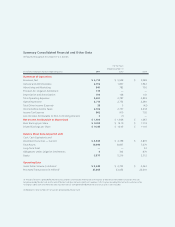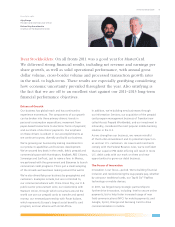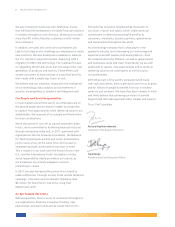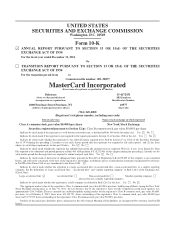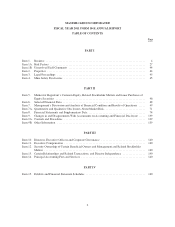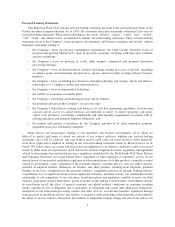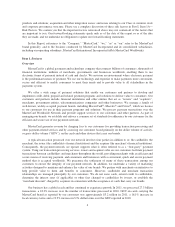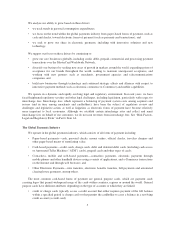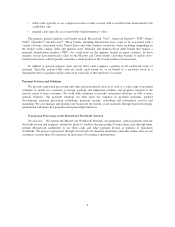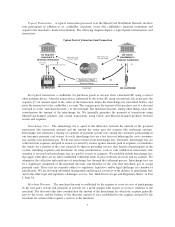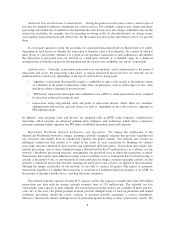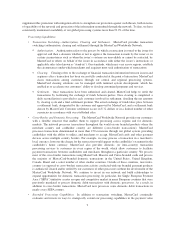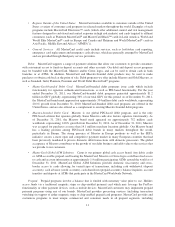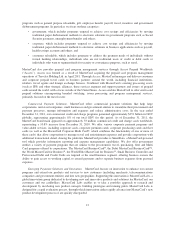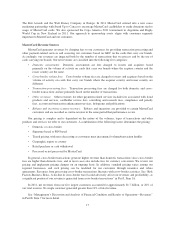MasterCard 2011 Annual Report Download - page 11
Download and view the complete annual report
Please find page 11 of the 2011 MasterCard annual report below. You can navigate through the pages in the report by either clicking on the pages listed below, or by using the keyword search tool below to find specific information within the annual report.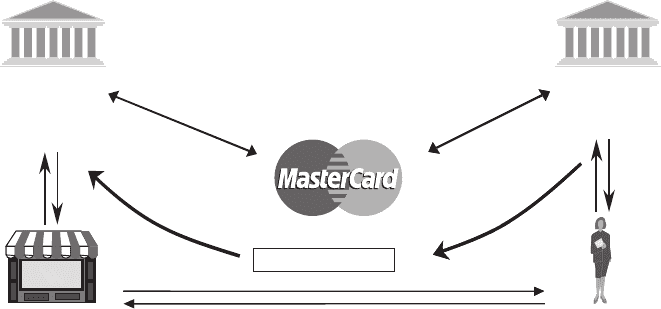
Typical Transaction. A typical transaction processed over the MasterCard Worldwide Network involves
four participants in addition to us: cardholder, merchant, issuer (the cardholder’s financial institution) and
acquirer (the merchant’s financial institution). The following diagram depicts a typical point-of-interaction card
transaction:
$
(less merchant discount)
Typical Point of Interaction Card Transaction
Authorization and
Transaction Data
Authorization and
Transaction Data
(C) Acquirer
(merchant’s
financial institution)
Transaction
Data Bill
$
(D) Issuer
(cardholder’s
financial institution)
$
(B) Merchant (A) Cardholder
Present Card
Goods and Services
Settlement Bank
$
In a typical transaction, a cardholder (A) purchases goods or services from a merchant (B) using a card or
other payment device. After the transaction is authorized by the issuer (D) using our network, the issuer pays the
acquirer (C) an amount equal to the value of the transaction, minus the interchange fee (described below), and
posts the transaction to the cardholder’s account. The acquirer pays the amount of the purchase, net of a discount
(referred to as the “merchant discount”), to the merchant. The merchant discount, among other things, takes into
consideration the amount of the interchange fee. We generally guarantee the payment of transactions using
MasterCard-branded products and certain transactions using Cirrus and Maestro-branded products between
issuers and acquirers.
Interchange Fees. The interchange fee is equal to the difference between the amount of the payment
transaction (the transaction amount) and the amount the issuer pays the acquirer (the settlement amount).
Interchange fees represent a sharing of a portion of payment system costs among the customers participating in
our four-party payment card system. As such, interchange fees are a key factor in balancing the costs consumers
pay and the costs merchants pay. We do not earn revenues from interchange fees. Generally, interchange fees are
collected from acquirers and paid to issuers (or netted by issuers against amounts paid to acquirers) to reimburse
the issuers for a portion of the costs incurred by them in providing services that benefit all participants in the
system, including acquirers and merchants. In some circumstances, such as cash withdrawal transactions, this
situation is reversed and interchange fees are paid by issuers to acquirers. We establish default interchange fees
that apply when there are no other established settlement terms in place between an issuer and an acquirer. We
administer the collection and remittance of interchange fees through the settlement process. Interchange fees can
be a significant component of the merchant discount, and therefore of the costs that merchants pay to accept
payment cards. These fees are currently subject to regulatory, legislative and/or legal challenges in a number of
jurisdictions. We are devoting substantial management and financial resources to the defense of interchange fees
and to the other legal and regulatory challenges we face. See “Risk Factors-Legal and Regulatory Risks” in Part
I, Item 1A.
Merchant Discount. The merchant discount is established by the acquirer to cover its costs of participating
in the four-party system and generally to provide for a profit margin with respect to services rendered to the
merchant. The discount takes into consideration the amount of the interchange fee which the acquirer generally
pays to the issuer, and the balance of the discount consists of fees established by the acquirer and paid by the
merchant for certain of the acquirer’s services to the merchant.
7


